BLOG - Page 28
Recently created mixtures:

Sea-Buckthorn Macerated oil
February 7, 2019

Home made air freshener
June 29, 2016

Homemade Dog-rose distillate
June 28, 2016

Homemade jasmine distillate
June 22, 2016

Moxibustion treatment with Moxa stick
May 30, 2016

Face and body gentle oil cleanser
May 26, 2016
BLOG / LATEST ADDITIONS!
Rosemary Verbenone Essential Oil (Rosmarinus Officinalis ct. Verbenone) ☸ Essential oils ☸ Base / General
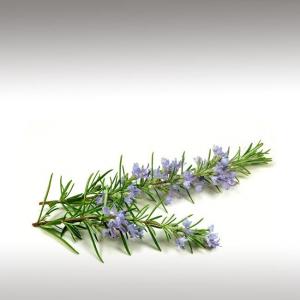

Botanical Name: Rosmarinus officinalis ct. verbenone
Common Method of Extraction: Steam Distilled
Part Typically Used: Leaves and flowers
Color: Clear/Pale yellow
Consistency: Thin
Perfumery Note: Middle
Strength of Initial Aroma: Fresh, herbaceous, sweet, slightly medicinal, strong, penetrating, fresh woody-herbaceous and somewhat minty-coniferous aroma.
There are three varieties of rosemary that you may see in aromatherapy:
Rosmarinus officinalis ct. cineole
Rosmarinus officinalis ct. verbenone
Rosmarinus officinalis ct. camphor
In the names there above, “ct.” stands for “Hemotype,” which simply means variety. Chemotypes, or varieties, in Rosemary occur because of conditions like inherent plant variety, light, soil, location, and temperature of where it is grown.
Rosmarinus Officinalis ct. Verbenone plant native to the Mediterranean region, growing wild in Spain, Portugal, southern France, Corsica, Italy, Sardinia, the former Yugoslavia, Russia, Turkey, the Middle East, and northern Africa. The essential oilis produced mainly in France, Spain, Morocco, and Tunisia.
Rosmarinus Officinalis ct Verbenone is a woody perennial evergreen and drought-resistant shrub that grows to a height 2 meters with thin dark green needle-shaped leaves and flowers that bloom from early summer through fall. The whole plant is highly aromatic. Rosemary essential oil is obtained from distillation of the fresh leaves and the flowering tops.
This popular herb has roots in mythology, medicine, culinary arts, magic, and literature that go back thousands of years. In ancient times, Greeks scholars wore strands of fresh Rosemary around their necks as they studied to improve memory and concentration.
In Greek mythology, Aphrodite was born from the sea. She rose up from the foaming waves adorned with garlands of Rosemary. Aphrodite is the Greek goddess of love, beauty, and pleasure. Rosemary has also been symbolic for remembrance and loyalty, and it has also been used in weddings and funerals in ages past.
It is a member of the mint family Lamiaceae, which also includes many other herbs. The name Rosemary derives from the Latin name Rosmarinus, which is from "Dew" (Ros) and "Sea" (Marinus), or "Dew of the sea", apparently because it is frequently found growing near the sea.
Regarding the difference in Rosemary essential oils, it is important to note that Rosemary ct Verbenone is milder (and has a milder aroma) than Rosemary ct cineol due to its lower camphor and higher verbenone content.
Rosmarinus Officinalis ct. Verbenone is with a strong, penetrating, fresh woody-herbaceous and somewhat minty-coniferous aroma; the dry out has a clean, long lasting, dry - herbaceous tone.
Common Method of Extraction: Steam Distilled
Part Typically Used: Leaves and flowers
Color: Clear/Pale yellow
Consistency: Thin
Perfumery Note: Middle
Strength of Initial Aroma: Fresh, herbaceous, sweet, slightly medicinal, strong, penetrating, fresh woody-herbaceous and somewhat minty-coniferous aroma.
There are three varieties of rosemary that you may see in aromatherapy:
Rosmarinus officinalis ct. cineole
Rosmarinus officinalis ct. verbenone
Rosmarinus officinalis ct. camphor
In the names there above, “ct.” stands for “Hemotype,” which simply means variety. Chemotypes, or varieties, in Rosemary occur because of conditions like inherent plant variety, light, soil, location, and temperature of where it is grown.
Rosmarinus Officinalis ct. Verbenone plant native to the Mediterranean region, growing wild in Spain, Portugal, southern France, Corsica, Italy, Sardinia, the former Yugoslavia, Russia, Turkey, the Middle East, and northern Africa. The essential oilis produced mainly in France, Spain, Morocco, and Tunisia.
Rosmarinus Officinalis ct Verbenone is a woody perennial evergreen and drought-resistant shrub that grows to a height 2 meters with thin dark green needle-shaped leaves and flowers that bloom from early summer through fall. The whole plant is highly aromatic. Rosemary essential oil is obtained from distillation of the fresh leaves and the flowering tops.
This popular herb has roots in mythology, medicine, culinary arts, magic, and literature that go back thousands of years. In ancient times, Greeks scholars wore strands of fresh Rosemary around their necks as they studied to improve memory and concentration.
In Greek mythology, Aphrodite was born from the sea. She rose up from the foaming waves adorned with garlands of Rosemary. Aphrodite is the Greek goddess of love, beauty, and pleasure. Rosemary has also been symbolic for remembrance and loyalty, and it has also been used in weddings and funerals in ages past.
It is a member of the mint family Lamiaceae, which also includes many other herbs. The name Rosemary derives from the Latin name Rosmarinus, which is from "Dew" (Ros) and "Sea" (Marinus), or "Dew of the sea", apparently because it is frequently found growing near the sea.
Regarding the difference in Rosemary essential oils, it is important to note that Rosemary ct Verbenone is milder (and has a milder aroma) than Rosemary ct cineol due to its lower camphor and higher verbenone content.
Rosmarinus Officinalis ct. Verbenone is with a strong, penetrating, fresh woody-herbaceous and somewhat minty-coniferous aroma; the dry out has a clean, long lasting, dry - herbaceous tone.
Submitted by OperaDreamhouse (March 3, 2015)
Eucalyptus Essential Oil (Eucalyptus Globulus) ☸ Essential oils ☸ Base / General
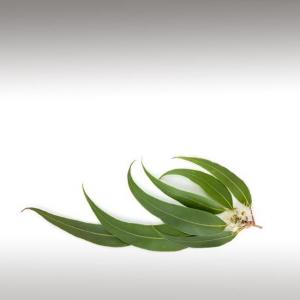

Botanical Name: Eucalyptus globulus
Common Method of Extraction: Steam distilled
Part Typically Used: Leaves and twigs
Color: Pale yellow
Consistency: Thin
Perfumery Note: Top
Strength of Initial Aroma: Fresh and earthy aroma. A clear, sharp, fresh and very distinctive smell.
Eucalyptus Globulus forms tall, open forests, growing in monospecific stands or with other species of Eucalypt. It can grow as a stunted shrub in extreme environments, such as on rock outcrops. It is adapted to temperate environments with winter rainfall and sufficient summer rainfall, and thrives in the cool zones of tropical mountains. It is widely planted across southern Australia. Recently, the species has also been planted in its native Tasmania where it is an important pulpwood source.
The Australian Aborigines calls it "Kino" and they use the leaves to cover serious wounds. Eucalyptus oil was introduced to Europe in 1788, and the first oil exported to England was called "Sydney Peppermint".
The Tasmanian Blue Gum, Southern Blue Gum or Blue Gum, (Eucalyptus Globulus) is an evergreen tree, one of the most widely cultivated trees native to Australia. They typically grow from 30 - 55 m tall. The mature leaves are narrow, sickle-shaped and dark shining green. They are arranged alternately on rounded stems and range from 15 - 35 cm in length. The leaves are leathery in texture, hang obliquely or vertically, and are studded with glands containing a fragrant volatile oil.
The first leaves are broad, without stalks, of a shining whitish-green and are opposite and horizontal, but after four or five years these are succeeded by others of a more ensiform or sword-shaped form, 6 to 12 inches long, bluish - green in hue, which are alternate and vertical, with the edges turned towards the sky and earth, an arrangement more suited to the climate and productive of peculiar effects of light and shade. The flowers are single or in clusters, almost stalkless.
Eucalyptus Globulus is the primary source of global Eucalyptus oil production, with China being the largest commercial producer. The oil has therapeutic, perfumery, flavoring, antimicrobial and biopesticide properties. Oil yield ranges from 1,0 - 2,4% (fresh weight), with cineole being the major isolate.
Eucalyptus comes from a Latin word "Obliquus" meaning "Oblique"” referring to the base of the leaf where the two sides of the leaf blade are of unequal length.
Eucalyptus Globulus has a pleasing and cool, crisp fragrance. Diffuse it in your home daily to alleviate congestion and to help purify the air.
Chemical structure:
The yield of oil from the leaves and branches averages from 0,75 to 1,25%. The cineole content is between 60 - 70% and since in many instances the properties of the crude oil do not meet the specifications of most pharmacopoeias, the oil has to be treated to increase the cineole content.
Eucalyptus Oil contains also, after exposure to the air, a crystallizable resin, derived from Eucalyptol.
Common Method of Extraction: Steam distilled
Part Typically Used: Leaves and twigs
Color: Pale yellow
Consistency: Thin
Perfumery Note: Top
Strength of Initial Aroma: Fresh and earthy aroma. A clear, sharp, fresh and very distinctive smell.
Eucalyptus Globulus forms tall, open forests, growing in monospecific stands or with other species of Eucalypt. It can grow as a stunted shrub in extreme environments, such as on rock outcrops. It is adapted to temperate environments with winter rainfall and sufficient summer rainfall, and thrives in the cool zones of tropical mountains. It is widely planted across southern Australia. Recently, the species has also been planted in its native Tasmania where it is an important pulpwood source.
The Australian Aborigines calls it "Kino" and they use the leaves to cover serious wounds. Eucalyptus oil was introduced to Europe in 1788, and the first oil exported to England was called "Sydney Peppermint".
The Tasmanian Blue Gum, Southern Blue Gum or Blue Gum, (Eucalyptus Globulus) is an evergreen tree, one of the most widely cultivated trees native to Australia. They typically grow from 30 - 55 m tall. The mature leaves are narrow, sickle-shaped and dark shining green. They are arranged alternately on rounded stems and range from 15 - 35 cm in length. The leaves are leathery in texture, hang obliquely or vertically, and are studded with glands containing a fragrant volatile oil.
The first leaves are broad, without stalks, of a shining whitish-green and are opposite and horizontal, but after four or five years these are succeeded by others of a more ensiform or sword-shaped form, 6 to 12 inches long, bluish - green in hue, which are alternate and vertical, with the edges turned towards the sky and earth, an arrangement more suited to the climate and productive of peculiar effects of light and shade. The flowers are single or in clusters, almost stalkless.
Eucalyptus Globulus is the primary source of global Eucalyptus oil production, with China being the largest commercial producer. The oil has therapeutic, perfumery, flavoring, antimicrobial and biopesticide properties. Oil yield ranges from 1,0 - 2,4% (fresh weight), with cineole being the major isolate.
Eucalyptus comes from a Latin word "Obliquus" meaning "Oblique"” referring to the base of the leaf where the two sides of the leaf blade are of unequal length.
Eucalyptus Globulus has a pleasing and cool, crisp fragrance. Diffuse it in your home daily to alleviate congestion and to help purify the air.
Chemical structure:
The yield of oil from the leaves and branches averages from 0,75 to 1,25%. The cineole content is between 60 - 70% and since in many instances the properties of the crude oil do not meet the specifications of most pharmacopoeias, the oil has to be treated to increase the cineole content.
Eucalyptus Oil contains also, after exposure to the air, a crystallizable resin, derived from Eucalyptol.
Submitted by OperaDreamhouse (March 3, 2015)
Refined Coconut Oil (Cocos Nucifera) ☸ Base oils ☸ Base / General
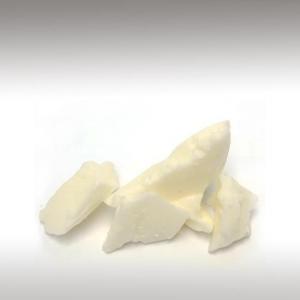

Refined Coconut oil differs from Pure Coconut oil in many respects. First, won’t find the typical Coconut scent or taste of Coconut in the oil, unlike in Pure Coconut oil.
Refined Coconut oil is the most widely used form of Coconut oil worldwide, if not the purest or the best. It is also known by the name of RBD Coconut oil, which stands for refined, bleached, and deodorized Coconut oil.
Actually, the oil that is expelled directly from copra is not fit for consumption, since it may contain dust particles, insect remains, spawns, microbes, fungal spores and many other such substances that may be harmful for health. In almost every case, the kernels are cut open and spread open in the strong sun to dry, with their flesh facing the sun. They are kept like that for days, weeks, or even months until they dry up as desired. They are not even covered with nets.
There is no special technique involved in the extraction of Refined Coconut oil. In fact, no Coconut oil is refined when it is expelled. It is expelled from copra using a bullock or machine driven expeller, just like any other oil.
The best quality Refined Coconut oils are cleaned using a natural, chemical free process, which are A-okay for consumption.
The Refined Organic Coconut oil is processed using the organically approved methods of physical extraction and refining. For the extraction step, the Coconuts are broken into pieces and the Coconut meatis allowed to dry, and once it is dried, the meat or flesh of the Coconut is hydraulically pressed at 100 - 130 degrees to extract the oil. The resulting oil is passed through a filter press to produce the finished material, but it still has to go through the RBD (refining, bleaching and deodorizing) process. The refining, bleaching, and deodorizing process goes as follows:
Product is de-gummed through addition of citric acid.
Product is bleached through addition activated charcoal.
The filtering aid diatomaceous earth is added prior to filtering step, which removes the processing aidsadded in the previous steps.
Product is deodorized with steam and vacuum methods.
This physical refining process is entirely acceptable and approved under organic processing regulations. Note that the items added during the process (citric acid, activated charcoal, and diatomaceous earth) are classified as “processing aids” and not additives because they are entirely removed during processing and are not found in the finished product.
Being refined, it is certainly more hygienic than the crude Coconut oil, but not that beneficial from the point of view of health. It is left with almost no proteins or minerals due to this processing. However, its shelf life is longer than that of crude or Pure Coconut oil.
It is cheaper than the same crude oil when it comes with a “Pure Coconut oil” tag. Again, it is far cheaper than its other sisters like the Organic Coconut oil, Virgin Coconut oil and Organic Virgin Coconut oil.
If you’re looking for the benefits of Coconut oil’s fatty acids, you’ll still find them in the Refined oil.
Fatty Acids:
Caprylic - 11,57%
Capric - 6,66%
Oleic - 4,39%
Lauric - 48,78%
Linoleic - 0,95%
Myristic - 18,98%
Stearic - 1,75%
Refined Coconut oil is the most widely used form of Coconut oil worldwide, if not the purest or the best. It is also known by the name of RBD Coconut oil, which stands for refined, bleached, and deodorized Coconut oil.
Actually, the oil that is expelled directly from copra is not fit for consumption, since it may contain dust particles, insect remains, spawns, microbes, fungal spores and many other such substances that may be harmful for health. In almost every case, the kernels are cut open and spread open in the strong sun to dry, with their flesh facing the sun. They are kept like that for days, weeks, or even months until they dry up as desired. They are not even covered with nets.
There is no special technique involved in the extraction of Refined Coconut oil. In fact, no Coconut oil is refined when it is expelled. It is expelled from copra using a bullock or machine driven expeller, just like any other oil.
The best quality Refined Coconut oils are cleaned using a natural, chemical free process, which are A-okay for consumption.
The Refined Organic Coconut oil is processed using the organically approved methods of physical extraction and refining. For the extraction step, the Coconuts are broken into pieces and the Coconut meatis allowed to dry, and once it is dried, the meat or flesh of the Coconut is hydraulically pressed at 100 - 130 degrees to extract the oil. The resulting oil is passed through a filter press to produce the finished material, but it still has to go through the RBD (refining, bleaching and deodorizing) process. The refining, bleaching, and deodorizing process goes as follows:
Product is de-gummed through addition of citric acid.
Product is bleached through addition activated charcoal.
The filtering aid diatomaceous earth is added prior to filtering step, which removes the processing aidsadded in the previous steps.
Product is deodorized with steam and vacuum methods.
This physical refining process is entirely acceptable and approved under organic processing regulations. Note that the items added during the process (citric acid, activated charcoal, and diatomaceous earth) are classified as “processing aids” and not additives because they are entirely removed during processing and are not found in the finished product.
Being refined, it is certainly more hygienic than the crude Coconut oil, but not that beneficial from the point of view of health. It is left with almost no proteins or minerals due to this processing. However, its shelf life is longer than that of crude or Pure Coconut oil.
It is cheaper than the same crude oil when it comes with a “Pure Coconut oil” tag. Again, it is far cheaper than its other sisters like the Organic Coconut oil, Virgin Coconut oil and Organic Virgin Coconut oil.
If you’re looking for the benefits of Coconut oil’s fatty acids, you’ll still find them in the Refined oil.
Chemical structure:
Fatty Acids:
Caprylic - 11,57%
Capric - 6,66%
Oleic - 4,39%
Lauric - 48,78%
Linoleic - 0,95%
Myristic - 18,98%
Stearic - 1,75%
Submitted by OperaDreamhouse (March 1, 2015)
Black Pepper Essential Oil (Piper Nigrum) ☸ Essential oils ☸ Base / General
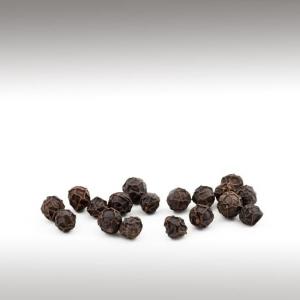

Botanical Name: Piper nigrum
Common Method of Extraction: Steam Distilled
Part Typically Used: Peppercorns
Color: Clear
Consistency: Thin
Perfumery Note: Middle/Base
Strength of Initial Aroma: Crisp, fresh, peppercorn aroma, strong and sharp spicy
Black Pepper (Piper Nigrum) is a flowering vine in the family Piperaceae, cultivated for its fruit, which is usually dried and used as a spice and seasoning. The fruit, known as a Peppercorn when dried, is approximately 5 millimetres in diameter, dark red when fully mature, and, like all drupes, contains a single seed. Peppercorns, and the ground pepper derived from them, may be described simply as Pepper, or more precisely as Black Pepper (cooked and dried unripe fruit), Green Pepper (dried unripe fruit) and White Pepper (ripe fruit seeds).
The Pepper plant is a perennial woody vine growing up to 4 metres in height on supporting trees, poles, or trellises. It is a spreading vine, rooting readily where trailing stems touch the ground. The flowers are small, produced on pendulous spikes 4 to 8 cm long at the leaf nodes, the spikes lengthening up to 7 to 15 cm as the fruit matures.The fruit of the Black Pepper is called a drupe and when dried it is a peppercorn.
The word Pepper is derived from the Latin word Piper, which in turn is taken from the Sanskrit word Pippali.
Black Peppercorns were found stuffed in the nostrils of Ramesses II, placed there as part of the mummification rituals shortly after his death in 1213 BCE. Little else is known about the use of Pepper in ancient Egypt and how it reached the Nile from South Asia.
Pepper was known in Greece at least as early as the 4th century BCE, though it was probably an uncommon and expensive item that only the very rich could afford.
The plant originated from India, Malaysia, Madagascar, China and Indonesia and the oil is mostly made in Singapore, India and Malaysia. The unripe, sun-dried peppercorns (fruit) are used for the extraction of the oil, using steam distillation which produces a yield of nearly 2%.
Common Method of Extraction: Steam Distilled
Part Typically Used: Peppercorns
Color: Clear
Consistency: Thin
Perfumery Note: Middle/Base
Strength of Initial Aroma: Crisp, fresh, peppercorn aroma, strong and sharp spicy
Black Pepper (Piper Nigrum) is a flowering vine in the family Piperaceae, cultivated for its fruit, which is usually dried and used as a spice and seasoning. The fruit, known as a Peppercorn when dried, is approximately 5 millimetres in diameter, dark red when fully mature, and, like all drupes, contains a single seed. Peppercorns, and the ground pepper derived from them, may be described simply as Pepper, or more precisely as Black Pepper (cooked and dried unripe fruit), Green Pepper (dried unripe fruit) and White Pepper (ripe fruit seeds).
The Pepper plant is a perennial woody vine growing up to 4 metres in height on supporting trees, poles, or trellises. It is a spreading vine, rooting readily where trailing stems touch the ground. The flowers are small, produced on pendulous spikes 4 to 8 cm long at the leaf nodes, the spikes lengthening up to 7 to 15 cm as the fruit matures.The fruit of the Black Pepper is called a drupe and when dried it is a peppercorn.
The word Pepper is derived from the Latin word Piper, which in turn is taken from the Sanskrit word Pippali.
Black Peppercorns were found stuffed in the nostrils of Ramesses II, placed there as part of the mummification rituals shortly after his death in 1213 BCE. Little else is known about the use of Pepper in ancient Egypt and how it reached the Nile from South Asia.
Pepper was known in Greece at least as early as the 4th century BCE, though it was probably an uncommon and expensive item that only the very rich could afford.
The plant originated from India, Malaysia, Madagascar, China and Indonesia and the oil is mostly made in Singapore, India and Malaysia. The unripe, sun-dried peppercorns (fruit) are used for the extraction of the oil, using steam distillation which produces a yield of nearly 2%.
Submitted by OperaDreamhouse (March 1, 2015)
True Cardamom Essential Oil (Elettaria Cardamomum) ☸ Essential oils ☸ Base / General
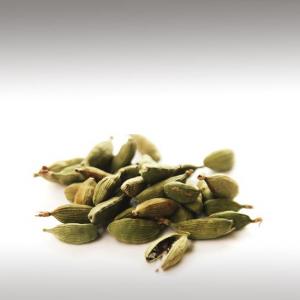

Botanical Name: Elettaria cardamomum
Common Method of Extraction: Steam Distilled
Part Typically Used: Fruits / Seeds
Color: Clear
Consistency: Thin
Perfumery Note: Middle/Base
Strength of Initial Aroma: Spicy, woody, rich, sweet.
A perennial, reed-like herb, Cardamom grows wild and is cultivated in India and Ceylon. Southern India and Sri Lanka. Indian Cardamom is slightly smaller, but more aromatic. Today it also grows in Sri Lanka, Guatemala, Indo China, Tanzania, El Salvador, Vietnam, Laos and Cambodia.
Although India is the largest producer of Cardamom, only a small share of the Indian production is exported because of the large domestic demand. The main exporting country is Guatemala, where Cardamom cultivation has been introduced to less than a century ago and where all cardamom is grown for export.
Cardamom is one of the world’s very ancient spices and also the third most expensive one next to Saffron and Vanilla.
In the 11th century in India cardamom was included in the list of ingredients for Panchasugandha-thambula or "Five-fragrance betel chew" in the Manasollasa or Book of Splendour. It was also included in recipes from the court of the Sultan of Mandu dating from about 1500. These recipes include sherbets and rice dishes flavoured with Cardamom.
True Cardamom, also known as Green Cardamom, became an article of trade with South Asia in the last thousand years when Arab traders brought it into widespread use. Exports from the Malabar Coast, close to where cardamoms grew wild, were described by the Portuguese traveller Barbosa in 1524.
Chemical structure:
The content of True Cardamon essential oil in the seeds is strongly dependent on storage conditions, but may be as high as 8%. The oil is composed almost exclusively of oxygenated monoterpene derivatives.
Cardamom seeds contain about 2% of fixed oil dominated by C16 fatty acids (oleic andpalmitic acid).
Common Method of Extraction: Steam Distilled
Part Typically Used: Fruits / Seeds
Color: Clear
Consistency: Thin
Perfumery Note: Middle/Base
Strength of Initial Aroma: Spicy, woody, rich, sweet.
A perennial, reed-like herb, Cardamom grows wild and is cultivated in India and Ceylon. Southern India and Sri Lanka. Indian Cardamom is slightly smaller, but more aromatic. Today it also grows in Sri Lanka, Guatemala, Indo China, Tanzania, El Salvador, Vietnam, Laos and Cambodia.
Although India is the largest producer of Cardamom, only a small share of the Indian production is exported because of the large domestic demand. The main exporting country is Guatemala, where Cardamom cultivation has been introduced to less than a century ago and where all cardamom is grown for export.
Cardamom is one of the world’s very ancient spices and also the third most expensive one next to Saffron and Vanilla.
In the 11th century in India cardamom was included in the list of ingredients for Panchasugandha-thambula or "Five-fragrance betel chew" in the Manasollasa or Book of Splendour. It was also included in recipes from the court of the Sultan of Mandu dating from about 1500. These recipes include sherbets and rice dishes flavoured with Cardamom.
True Cardamom, also known as Green Cardamom, became an article of trade with South Asia in the last thousand years when Arab traders brought it into widespread use. Exports from the Malabar Coast, close to where cardamoms grew wild, were described by the Portuguese traveller Barbosa in 1524.
Chemical structure:
The content of True Cardamon essential oil in the seeds is strongly dependent on storage conditions, but may be as high as 8%. The oil is composed almost exclusively of oxygenated monoterpene derivatives.
Cardamom seeds contain about 2% of fixed oil dominated by C16 fatty acids (oleic andpalmitic acid).
Submitted by OperaDreamhouse (March 1, 2015)
Tahitian Gardenia Flower (Gardenia Tahitensis) ☸ Plants ☸ Base / General
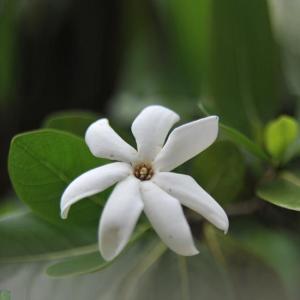

Gardenia Taitensis (also called Tahitian Gardenia or Tiaré Flower) is a species of plant in the Rubiaceae family. It is an evergreen tropical shrub that grows to 4 m tall, it has glossy dark green leaves that are oppositely arranged along the stem.
The flower is creamy white, pinwheel-shaped with 5 to 9 lobes and very fragrant. Native to the highland shores of the South Pacific, it has the distinction of being one of the few cultivated plants native to Polynesia. It is the national flower of French Polynesia and the Cook Islands.
Gardenia Tahitensis is known all around the world as Tiare from Tahiti or Tiare Mahoi. Tiare is a national symbol of Tahiti, often celebrated as the flower of affection, having delicate snow-white petals that stand for the language of love.
The scent of Tiare is heady and hypnotic, spreading sweet and exotic aromas.
Polynesian people in the pacific islands use the extremely fragrant blooms in their flower necklaces, which are called "Ei" in the Cook Islands, "Hei" in Tahiti or "Lei" in Hawai'i.
In some Pacific Island traditions, wearing a flower indicates relationship status. A flower worn on the left ear means the person is taken and on the right ear means available.
Tiare is a soul and a symbol of Tahiti. Both men and women wear these fragrant flowers during special ceremonies and holidays.
The flower is used to make Monoi Tiare Tahiti, a perfume-oil made by infusing the blossoms in Coconut oil.
The flower is creamy white, pinwheel-shaped with 5 to 9 lobes and very fragrant. Native to the highland shores of the South Pacific, it has the distinction of being one of the few cultivated plants native to Polynesia. It is the national flower of French Polynesia and the Cook Islands.
Gardenia Tahitensis is known all around the world as Tiare from Tahiti or Tiare Mahoi. Tiare is a national symbol of Tahiti, often celebrated as the flower of affection, having delicate snow-white petals that stand for the language of love.
The scent of Tiare is heady and hypnotic, spreading sweet and exotic aromas.
Polynesian people in the pacific islands use the extremely fragrant blooms in their flower necklaces, which are called "Ei" in the Cook Islands, "Hei" in Tahiti or "Lei" in Hawai'i.
In some Pacific Island traditions, wearing a flower indicates relationship status. A flower worn on the left ear means the person is taken and on the right ear means available.
Tiare is a soul and a symbol of Tahiti. Both men and women wear these fragrant flowers during special ceremonies and holidays.
The flower is used to make Monoi Tiare Tahiti, a perfume-oil made by infusing the blossoms in Coconut oil.
Submitted by OperaDreamhouse (February 28, 2015)
Champak Flower (Michelia Champaca) ☸ Plants ☸ Base / General
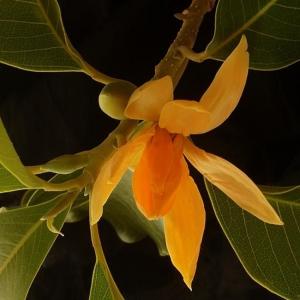

Michelia is a genus of flowering plants belonging to the Magnolia family. The genus includes about 50 species of evergreen trees and shrubs, native to tropical and subtropical south and southeast Asia (Indomalaya), including southern China.
Michelia Champaca, known in English as Champak, is a large evergreen tree, native to the Indomalaya ecozone (consisting of South Asia, Southeast Asia and some parts of China).
It is best known for its strongly fragrant yellow or white flowers. It is, however, primarily cultivated for its timber, and is also used in urban landscaping. Its aril-covered seeds are highly attractive to birds.
The flowers are used in Southeast Asia for several purposes. Especially in India, they are primarily used for worship at temples whether at home or out, and more generally worn in hair by girls and women as a means of beauty ornament as well as a natural perfume. Flowers are used to be floated in bowls of water to scent the room, as a fragrant decoration for bridal beds, and for garlands.
In Theravada Buddhism, Champak is said to have used as the tree for achieved enlightenment, or Bodhi by Seventeenth Lord Buddha called "Aththadassi".
Michelia Champaca, known in English as Champak, is a large evergreen tree, native to the Indomalaya ecozone (consisting of South Asia, Southeast Asia and some parts of China).
It is best known for its strongly fragrant yellow or white flowers. It is, however, primarily cultivated for its timber, and is also used in urban landscaping. Its aril-covered seeds are highly attractive to birds.
The flowers are used in Southeast Asia for several purposes. Especially in India, they are primarily used for worship at temples whether at home or out, and more generally worn in hair by girls and women as a means of beauty ornament as well as a natural perfume. Flowers are used to be floated in bowls of water to scent the room, as a fragrant decoration for bridal beds, and for garlands.
In Theravada Buddhism, Champak is said to have used as the tree for achieved enlightenment, or Bodhi by Seventeenth Lord Buddha called "Aththadassi".
Submitted by OperaDreamhouse (February 28, 2015)
Ylang - Ylang Flower (Cananga Odorata) ☸ Plants ☸ Base / General
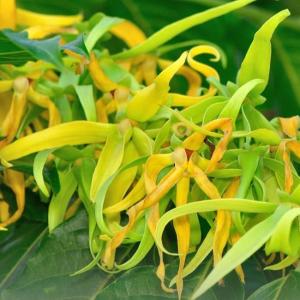

Cananga Odorata, commonly called Ylang-Ylang, Cananga Tree, Ilang-Ilang, Kenanga in Indonesian, Fragrant Cananga, Macassar-oil plant or Perfume Tree, is a tropical tree which originates from the Philippines and is valued for its perfume.
The name Ylang-Ylang is derived from Tagalog, either from the word ilang, meaning "Wilderness", alluding to its natural habitat, or the word Ilang-Ilan, meaning "Rare", suggestive of its exceptionally delicate scent. A common mistranslation is "Flower of flowers". The plant is native to the Philippines and Indonesia and is commonly grown in Polynesia, Melanesia, Micronesia and Comoros Islands.
Cananga Odorata is a fast-growing tree of the custard apple family Annonaceae. Its growth exceeds 5 m per year and attains an average height of 12 m in an ideal climate.
It grows in full or partial sun, and prefers the acidic soils of its native rainforest habitat. The evergreen leaves are smooth and glossy, oval, pointed and with wavy margins, and 13 - 20 cm long. The flower is drooping, long-stalked, with six narrow, greenish-yellow petals, rather like a sea star in appearance, and yields a highly fragrant essential oil.
The name Ylang-Ylang is derived from Tagalog, either from the word ilang, meaning "Wilderness", alluding to its natural habitat, or the word Ilang-Ilan, meaning "Rare", suggestive of its exceptionally delicate scent. A common mistranslation is "Flower of flowers". The plant is native to the Philippines and Indonesia and is commonly grown in Polynesia, Melanesia, Micronesia and Comoros Islands.
Cananga Odorata is a fast-growing tree of the custard apple family Annonaceae. Its growth exceeds 5 m per year and attains an average height of 12 m in an ideal climate.
It grows in full or partial sun, and prefers the acidic soils of its native rainforest habitat. The evergreen leaves are smooth and glossy, oval, pointed and with wavy margins, and 13 - 20 cm long. The flower is drooping, long-stalked, with six narrow, greenish-yellow petals, rather like a sea star in appearance, and yields a highly fragrant essential oil.
Submitted by OperaDreamhouse (February 28, 2015)
Calendula Plant (Calendula Officinalis) ☸ Plants ☸ Base / General
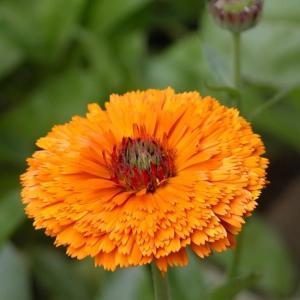

Calendula Officinalis (Pot Marigold, Ruddles, Cmmon Marigold, Garden Marigold, English Marigold, or Scottish Marigold) is a plant in the genus Calendula of the family Asteraceae. It is probably native to southern Europe, though its long history of cultivation makes its precise origin unknown, and it may possibly be of garden origin.
Calendula Officinalis is widely cultivated and can be grown easily in sunny locations in most kinds of soils. Although perennial, it is commonly treated as an annual, particularly in colder regions where its winter survival is poor and in hot summer locations where it also does not survive.
Calendula Officinalis is a short-lived aromatic herbaceous perennial, growing to 80 cm tall, with sparsely branched lax or erect stems.
The leaves are oblong-lanceolate, 5 - 17 cm long. The inflorescences are yellow, comprising a thick capitulum or flowerhead 4 - 7 cm diameter surrounded by two rows of hairy bracts. The disc florets are tubular and hermaphrodite, and generally of a more intense orange-yellow colour than the female, tridentate, peripheral ray florets.
The flowers may appear all year long where conditions are suitable. The fruit is a thorny curved achene.
Calendula Officinalis is widely cultivated and can be grown easily in sunny locations in most kinds of soils. Although perennial, it is commonly treated as an annual, particularly in colder regions where its winter survival is poor and in hot summer locations where it also does not survive.
Calendula Officinalis is a short-lived aromatic herbaceous perennial, growing to 80 cm tall, with sparsely branched lax or erect stems.
The leaves are oblong-lanceolate, 5 - 17 cm long. The inflorescences are yellow, comprising a thick capitulum or flowerhead 4 - 7 cm diameter surrounded by two rows of hairy bracts. The disc florets are tubular and hermaphrodite, and generally of a more intense orange-yellow colour than the female, tridentate, peripheral ray florets.
The flowers may appear all year long where conditions are suitable. The fruit is a thorny curved achene.
Submitted by OperaDreamhouse (February 28, 2015)
Cedar Nut Oil (Pinus Sibirica) ☸ Base oils ☸ Base / General
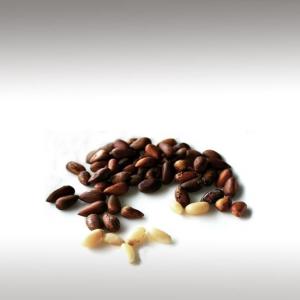

Pine Nut oil, also called Pine Seed oil or Cedar Nut oil, is a vegetable oil, extracted from the edible seeds of several species of pine. While the oil produced from the seeds of more common European and American pine varieties is mostly used for culinary purposes. Siberian Pines, growing in Russia, Mongolia and Kazakhstan, yield the seeds with the highest content of pinolenic acid, as well as antioxidants associated with medicinal uses.
Ringing Cedar is a Siberian Cedar which has aged over 550 years. After 550 years of it's life the Ringing Cedar starts making a pleasant humming sound which is a sign for people to use it's gathered energy.
The Siberian Taiga is one of the ecologically purest areas of the world. The virgin forest of the Taiga has never been treated with any chemicals or artificial fertilization nor abused by agricultural machines. All flora in the Taiga has been preserved in original condition by nature.
Producing Cedar Nuts and Cedar Nut oil is centuries-old tradition in Russia. Virgin Cedar Nut oil has an attractive light-amber colour and a pleasant nutty fragrance. Its flavour qualities surpass the best grades of Olive oil and Almond oil, and the strength of its medicinal effect exceeds Sea buckthorn, Burdock, Coconut, and high grade Olive oil.
The highly curative properties of Russia Cedar Nut oil are explained by the technology of preparation, which includes a method of cold-pressing and the gathering of Cedar Nuts by hand, allowing the product to retain all the great revitalizing strength of the Cedar tree.
In Siberia, since ancient times, it was believed that precisely the Cedar Nut was one of the chief riches of the Taiga. Cedar forests were always protected. Entire villages went out to collect nuts, moreover the number of trees from which families were to gather the nuts was determined earlier, taking into account the quantity of family members to feed. Usually the nut harvest lasted five to ten days, for the cleaning of the cones (shelling) was done right in the Taiga, using special devices. Unless “the community” consented otherwise, it was permitted to gather nuts only in distant Cedar forests, to which there were no roads.
Cedar Nut oil is not an inexpensive product, and cannot be inexpensive by virtue of the special features of its production. But the price of Cedar Nut oil is completely comparable to the price of pharmaceutical multivitamins, which often provoke allergic reactions and have a fairly questionable effectiveness. Abroad, Cedar Nut oil is very highly valued.
In cold pressing, the kernels, cleaned of their shells, are placed in a wooden press. The oil obtained settles or is filtered. During the processing, the oil is not permitted to come into contact with any metal parts. The Cedar Nut oil thus obtained is extremely wholesome, and is widely used in traditional medicine and cosmetology. This method is the most costly, but the result is of the highest quality.
Chemical structure:
The proteins of the oil include 19 amino acids, 70% of which are essential. Cedar Nut oil contains a large proportion of polyunsaturated fatty acids - linoleic, linolenic, oleic, arachidonic, palmitic, and stearic, trace elements - phosphorus, copper, magnesium, zinc, manganese, cobalt, iodine.
Linoleic acid - 49,0%
Oleic acid - 2,8%
Pinolenic acid - 17,1%
Palmitic acid - 6,3%
Stearic acid - 2,5%
Ringing Cedar is a Siberian Cedar which has aged over 550 years. After 550 years of it's life the Ringing Cedar starts making a pleasant humming sound which is a sign for people to use it's gathered energy.
The Siberian Taiga is one of the ecologically purest areas of the world. The virgin forest of the Taiga has never been treated with any chemicals or artificial fertilization nor abused by agricultural machines. All flora in the Taiga has been preserved in original condition by nature.
Producing Cedar Nuts and Cedar Nut oil is centuries-old tradition in Russia. Virgin Cedar Nut oil has an attractive light-amber colour and a pleasant nutty fragrance. Its flavour qualities surpass the best grades of Olive oil and Almond oil, and the strength of its medicinal effect exceeds Sea buckthorn, Burdock, Coconut, and high grade Olive oil.
The highly curative properties of Russia Cedar Nut oil are explained by the technology of preparation, which includes a method of cold-pressing and the gathering of Cedar Nuts by hand, allowing the product to retain all the great revitalizing strength of the Cedar tree.
In Siberia, since ancient times, it was believed that precisely the Cedar Nut was one of the chief riches of the Taiga. Cedar forests were always protected. Entire villages went out to collect nuts, moreover the number of trees from which families were to gather the nuts was determined earlier, taking into account the quantity of family members to feed. Usually the nut harvest lasted five to ten days, for the cleaning of the cones (shelling) was done right in the Taiga, using special devices. Unless “the community” consented otherwise, it was permitted to gather nuts only in distant Cedar forests, to which there were no roads.
Cedar Nut oil is not an inexpensive product, and cannot be inexpensive by virtue of the special features of its production. But the price of Cedar Nut oil is completely comparable to the price of pharmaceutical multivitamins, which often provoke allergic reactions and have a fairly questionable effectiveness. Abroad, Cedar Nut oil is very highly valued.
In cold pressing, the kernels, cleaned of their shells, are placed in a wooden press. The oil obtained settles or is filtered. During the processing, the oil is not permitted to come into contact with any metal parts. The Cedar Nut oil thus obtained is extremely wholesome, and is widely used in traditional medicine and cosmetology. This method is the most costly, but the result is of the highest quality.
Chemical structure:
The proteins of the oil include 19 amino acids, 70% of which are essential. Cedar Nut oil contains a large proportion of polyunsaturated fatty acids - linoleic, linolenic, oleic, arachidonic, palmitic, and stearic, trace elements - phosphorus, copper, magnesium, zinc, manganese, cobalt, iodine.
Linoleic acid - 49,0%
Oleic acid - 2,8%
Pinolenic acid - 17,1%
Palmitic acid - 6,3%
Stearic acid - 2,5%
Submitted by OperaDreamhouse (February 27, 2015)
Royal Jasmine Essential Oil (Jasminum Grandiflorum) ☸ Essential oils ☸ Base / General
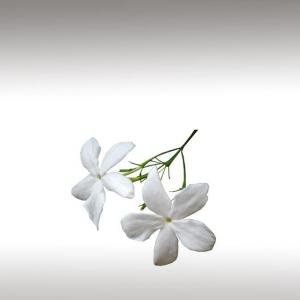

Botanical Name: Jasminum grandiflorum
Common Method of Extraction: Steam Distillation
Part Typically Used: Flowers
Color: Deep brown with a golden tinge
Consistency: Thick
Perfumery Note: Base
Strength of Initial Aroma: Sweet, exotic and richly floral smell
It is widely cultivated as an ornamental plant in warm temperate and subtropical regions. The term Jasmine is probably derived from Persian word Yasmine meaning "Fragrance", which is adopted in Arabic as Yasym given to Jasmine flowers.
Jasminum Grandiflorum, also known variously as the Spanish Jasmine, Royal Jasmine, Catalonian Jasmine, is a species of Jasmine native to South Asia (Nepal, Kashmir, and Northern Pakistan), the Arabian peninsula (Oman, Saudi Arabia), Northeast Africa (Eritrea, Ethiopia, Djibouti, Somalia, Sudan), the African Great Lakes (Kenya, Uganda, Rwanda), and the Yunnan and Sichuan regions of China.
The plant is known as "Saman Pichcha" or "Pichcha" in Sri Lanka. Buddhist and Hindu temples use these flowers in abundance.
It is a scrambling deciduous shrub growing to 2 - 4 m tall. The leaves are opposite, 5 - 12 cm long, pinnate with 5 - 11 leaflets. The flowers are produced in open cymes, the individual flowers are white having corolla with a basal tube 13 - 25 mm long and five lobes 13 - 22 mm long. The flower's fragrance is unique and sweet. The flowers open at night, and close in the morning.
Jasmines are a group of shrubs grown commercially for production of their fragrant flowers and essential oil.
The bulk of the flowers are used as such in garlands and decorative branches for religious offerings, and a small quantity is used for production of oils and attars. Jasmine concrete and absolute are used in high-grade perfumes, and come next to Rose in order of importance.
Since recent times, Jasmine has been concluded as the "King of Oils" (Rose is the "Queen"). Apparently this is because Jasmine is the most masculine of all the floral oils.
It takes eight million Jasmine flowers to create a single kilogram of essential oil, they must be hand-picked before sun-rise, and the essence is skillfully extracted, to give the highest grade of essential oil.
Common Method of Extraction: Steam Distillation
Part Typically Used: Flowers
Color: Deep brown with a golden tinge
Consistency: Thick
Perfumery Note: Base
Strength of Initial Aroma: Sweet, exotic and richly floral smell
It is widely cultivated as an ornamental plant in warm temperate and subtropical regions. The term Jasmine is probably derived from Persian word Yasmine meaning "Fragrance", which is adopted in Arabic as Yasym given to Jasmine flowers.
Jasminum Grandiflorum, also known variously as the Spanish Jasmine, Royal Jasmine, Catalonian Jasmine, is a species of Jasmine native to South Asia (Nepal, Kashmir, and Northern Pakistan), the Arabian peninsula (Oman, Saudi Arabia), Northeast Africa (Eritrea, Ethiopia, Djibouti, Somalia, Sudan), the African Great Lakes (Kenya, Uganda, Rwanda), and the Yunnan and Sichuan regions of China.
The plant is known as "Saman Pichcha" or "Pichcha" in Sri Lanka. Buddhist and Hindu temples use these flowers in abundance.
It is a scrambling deciduous shrub growing to 2 - 4 m tall. The leaves are opposite, 5 - 12 cm long, pinnate with 5 - 11 leaflets. The flowers are produced in open cymes, the individual flowers are white having corolla with a basal tube 13 - 25 mm long and five lobes 13 - 22 mm long. The flower's fragrance is unique and sweet. The flowers open at night, and close in the morning.
Jasmines are a group of shrubs grown commercially for production of their fragrant flowers and essential oil.
The bulk of the flowers are used as such in garlands and decorative branches for religious offerings, and a small quantity is used for production of oils and attars. Jasmine concrete and absolute are used in high-grade perfumes, and come next to Rose in order of importance.
Since recent times, Jasmine has been concluded as the "King of Oils" (Rose is the "Queen"). Apparently this is because Jasmine is the most masculine of all the floral oils.
It takes eight million Jasmine flowers to create a single kilogram of essential oil, they must be hand-picked before sun-rise, and the essence is skillfully extracted, to give the highest grade of essential oil.
Submitted by OperaDreamhouse (February 21, 2015)
Patchouli Essential Oil (Pogostemon Cablin) ☸ Essential oils ☸ Base / General
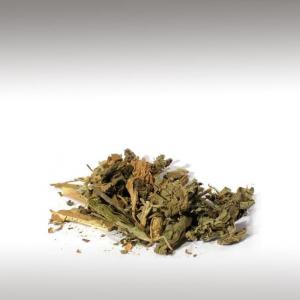

Botanical Name: Pogostemon cablin
Common Method of Extraction: Steam distillation
Part Typically Used: Young leaves
Color: Light yellow to dark brown in color
Consistency: Medium - Thick
Perfumery Note: Base
Strength of Initial Aroma: Rich musky-sweet, strong spicy and herbaceous smell
Patchouli (Pogostemon Cablin), Blanco, Patchouly or Pachouli is a species of plant from the genus Pogostemon. It is a bushy herb of the Mint family, with erect stems, reaching 0,75 m in height and bearing small, pale pink-white flowers.
The plant is native to tropical regions of Asia, and is now extensively cultivated in China, Indonesia, India, Malaysia, Mauritius, Taiwan, the Philippines, Thailand, and Vietnam, as well as West Africa.
The plant is native to Malaysia and India, where it is known as ''Puchaput''. The word is derived from Hindustan word ''Patch'' meaning ''Green'' and ''Ilai'' meaning ''Leaf''.
During the 18th and 19th century, silk traders from China traveling to the Middle East packed their silk cloth with dried Patchouli leaves to prevent moths from laying their eggs on the cloth. Many historians speculate that this association with opulent Eastern goods is why Patchouli was considered by Europeans of that era to be a luxurious scent.
It is said that Patchouli was used in the linen chests of Queen Victoria in this way.
Although this essential oil may remind people of the Hippie era. Patchouli is an important ingredient in East Asian incense. Both Patchouli oil and incense underwent a surge in popularity in the 1960s and 1970s in the US and Europe, mainly as a result of the hippie movement of those decades.
Patchouli oil is extracted from the young leaves which are dried and fermented prior to steam distillation and yields 2 - 3 %. This oil improves with age to have a fuller, more well rounded odor. Leaves may be harvested several times a year and, when dried, may be exported for distillation.
Some sources claim a highest quality oil is usually produced from fresh leaves distilled close to where they are harvested, others that baling the dried leaves and fermenting them for a period of time is best.
Chemical structure:
Two important components of its Patchouli essential oil arepatchoulol and norpatchoulenol.
Common Method of Extraction: Steam distillation
Part Typically Used: Young leaves
Color: Light yellow to dark brown in color
Consistency: Medium - Thick
Perfumery Note: Base
Strength of Initial Aroma: Rich musky-sweet, strong spicy and herbaceous smell
Patchouli (Pogostemon Cablin), Blanco, Patchouly or Pachouli is a species of plant from the genus Pogostemon. It is a bushy herb of the Mint family, with erect stems, reaching 0,75 m in height and bearing small, pale pink-white flowers.
The plant is native to tropical regions of Asia, and is now extensively cultivated in China, Indonesia, India, Malaysia, Mauritius, Taiwan, the Philippines, Thailand, and Vietnam, as well as West Africa.
The plant is native to Malaysia and India, where it is known as ''Puchaput''. The word is derived from Hindustan word ''Patch'' meaning ''Green'' and ''Ilai'' meaning ''Leaf''.
During the 18th and 19th century, silk traders from China traveling to the Middle East packed their silk cloth with dried Patchouli leaves to prevent moths from laying their eggs on the cloth. Many historians speculate that this association with opulent Eastern goods is why Patchouli was considered by Europeans of that era to be a luxurious scent.
It is said that Patchouli was used in the linen chests of Queen Victoria in this way.
Although this essential oil may remind people of the Hippie era. Patchouli is an important ingredient in East Asian incense. Both Patchouli oil and incense underwent a surge in popularity in the 1960s and 1970s in the US and Europe, mainly as a result of the hippie movement of those decades.
Patchouli oil is extracted from the young leaves which are dried and fermented prior to steam distillation and yields 2 - 3 %. This oil improves with age to have a fuller, more well rounded odor. Leaves may be harvested several times a year and, when dried, may be exported for distillation.
Some sources claim a highest quality oil is usually produced from fresh leaves distilled close to where they are harvested, others that baling the dried leaves and fermenting them for a period of time is best.
Chemical structure:
Two important components of its Patchouli essential oil arepatchoulol and norpatchoulenol.
Submitted by OperaDreamhouse (February 21, 2015)
Vetiver Essential Oil (Vetiveria Zizanioides) ☸ Essential oils ☸ Base / General
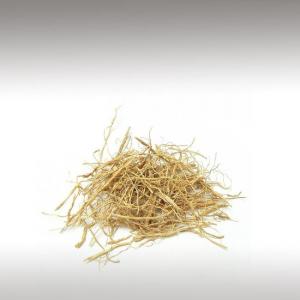

Botanical Name: Chrysopogon zizanioides
Common Method of Extraction: Steam distillation
Part Typically Used: Root
Color: Amber brown
Consistency: Thick
Perfumery Note: Base
Strength of Initial Aroma: Aroma is very earthy, deep, sweet, woody, smoky, amber, and balsam.
Chrysopogon Zizanioides, commonly known as Vetiver is a perennial grass of the Poaceae family, native to India.
Vetiver can grow up to 1,5 metres high and form clumps as wide. The stems are tall and the leaves are long, thin, and rather rigid, the flowers are brownish-purple. Unlike most grasses, which form horizontally spreading, mat-like root systems, Vetiver's roots grow downward, 2 - 4 m in depth. Vetiver has no stolons nor rhizomes. Because of all these characteristics, the Vetiver plant is highly drought-tolerant and can help to protect soil against sheet erosion. In case of sediment deposition, new roots can grow out of buried nodes.
Vetiver is most closely related to Sorghum but shares many morphological characteristics with other fragrant grasses, such as Lemongrass (Cymbopogon Citratus), Citronella (Cymbopogon Nardus), and Palmarosa (Cymbopogon Martinii).
Though it originates in India, vetiver is widely cultivated in the tropical regions of the world. The world's major producers include Haiti, India, Java, and Réunion. Vetiver comes from a Tamil name meaning "Hatcheted up".
Vetiver is mainly cultivated for the fragrant essential oildistilled from its roots. In perfumery, the older French spelling, Vetyver, is often used. Another major operation in the field is the one owned by the Boucard family. Réunion is considered to produce the highest quality Vetiver essential oil called "Bourbon Vetiver" with the next favorable being Haiti and then Java.
The best quality oil is obtained from 18 - 24 - month - old roots. The roots are dug up, cleaned, and then dried. Before the distillation, the roots are chopped and soaked in water. The distillation process can take up to 24 hours. After the distillate separates into the essential oiland hydrosol, the oil is skimmed off and allowed to age for a few months to allow some undesirable notes forming during the distillation to dissipate.
The oil distilled in Haiti and Réunion has a more floral quality and is considered of higher quality than the oil from Java, which has a smokier scent. In the north of India, oil is distilled from wild-growing Vetiver. This oil is known as "Khus" or "Khas", and in India is considered superior to the oil obtained from the cultivated Variety. It is rarely found in commerce outside of India, as most of it is consumed within the country.
Like Patchouli and Sandalwood essential oils, the odor of Vetiver develops and improves with aging.
Common Method of Extraction: Steam distillation
Part Typically Used: Root
Color: Amber brown
Consistency: Thick
Perfumery Note: Base
Strength of Initial Aroma: Aroma is very earthy, deep, sweet, woody, smoky, amber, and balsam.
Chrysopogon Zizanioides, commonly known as Vetiver is a perennial grass of the Poaceae family, native to India.
Vetiver can grow up to 1,5 metres high and form clumps as wide. The stems are tall and the leaves are long, thin, and rather rigid, the flowers are brownish-purple. Unlike most grasses, which form horizontally spreading, mat-like root systems, Vetiver's roots grow downward, 2 - 4 m in depth. Vetiver has no stolons nor rhizomes. Because of all these characteristics, the Vetiver plant is highly drought-tolerant and can help to protect soil against sheet erosion. In case of sediment deposition, new roots can grow out of buried nodes.
Vetiver is most closely related to Sorghum but shares many morphological characteristics with other fragrant grasses, such as Lemongrass (Cymbopogon Citratus), Citronella (Cymbopogon Nardus), and Palmarosa (Cymbopogon Martinii).
Though it originates in India, vetiver is widely cultivated in the tropical regions of the world. The world's major producers include Haiti, India, Java, and Réunion. Vetiver comes from a Tamil name meaning "Hatcheted up".
Vetiver is mainly cultivated for the fragrant essential oildistilled from its roots. In perfumery, the older French spelling, Vetyver, is often used. Another major operation in the field is the one owned by the Boucard family. Réunion is considered to produce the highest quality Vetiver essential oil called "Bourbon Vetiver" with the next favorable being Haiti and then Java.
The best quality oil is obtained from 18 - 24 - month - old roots. The roots are dug up, cleaned, and then dried. Before the distillation, the roots are chopped and soaked in water. The distillation process can take up to 24 hours. After the distillate separates into the essential oiland hydrosol, the oil is skimmed off and allowed to age for a few months to allow some undesirable notes forming during the distillation to dissipate.
The oil distilled in Haiti and Réunion has a more floral quality and is considered of higher quality than the oil from Java, which has a smokier scent. In the north of India, oil is distilled from wild-growing Vetiver. This oil is known as "Khus" or "Khas", and in India is considered superior to the oil obtained from the cultivated Variety. It is rarely found in commerce outside of India, as most of it is consumed within the country.
Like Patchouli and Sandalwood essential oils, the odor of Vetiver develops and improves with aging.
Submitted by OperaDreamhouse (February 20, 2015)
Atlantic Cedar Essential Oil (Cedrus Atlantica) ☸ Essential oils ☸ Base / General
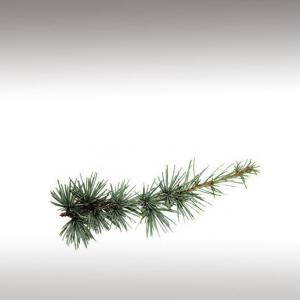

Botanical Name: Cedrus atlantica
Common Method of Extraction: Steam distilled
Part Typically Used: Wood and sawdust
Color: Light golden yellow to golden yellow
Consistency: Medium
Perfumery Note: Base
Strength of Initial Aroma: Woody, balsamic, rich dry overtones. Has a sweet and richly woody aroma with a camphoraceous base note.
Cedrus atlantica is a True cedar. It's common name is referred to as Atlantic cedar and it is also known as the Moroccan cedarwood.
Cedrus atlantica, the Atlas cedar, is a cedar native to the Atlas Mountains of Algeria and Morocco. Fully grown, Atlas cedar is a large coniferous evergreen tree, 30 - 35 m tall, with a trunk diameter of 2 m. It is very similar in all characters to the other varieties of Lebanon cedar, differences are hard to discern.
The wood is very aromatic due to the high content of essential oil it contains.
Because Cedars are reputed to be very long lived, they have been grown in churchyards. An enormous grove of cedars of Lebanon - from which King Solomon is said to have built his temple - exists still on the slopes of Mount Lebanon. The first cedar of Lebanon planted in Britain was in the Thames valley in 1646 - and it is still alive and healthy.
Cedars are the trees most mentioned in the Bible, symbolizing everything that was fertile and abundant.
The wood and its oil were used in embalming by the Ancient Egyptians. The Egyptians used Cedarwood in the embalming process and as a perfume ingredient.
Cedarwood has a long history as an incense and perfume. The wood was burned by the Greeks and Romans to fragrant the air.
For therapeutic use, the only recognized oil of cedar is that from the Atlantic, or Atlas, cedar which grows in Morocco. The Moroccans produced some 6 - 7 metric tonnes of oil per year in the late 1980 Cedarwood oil is steam-distilled from the wood itself, and it is like syrup, yellowish and very balsamic, it has a turpentine scent, but one which is sweeter and more agreeable, similar in some ways to Sandalwood.
Cedarwood was used to construct coffins. Like all conifers, Cedar is associated with eternal life and so it was hoped that a body placed in coffin fashioned from its wood would find easier access to the Otherworld.
Cedarwood essences, wood, wood shavings or powders were used in early potpourri and anti-moth bags. Many expensive fish are smoked over Cedarwood.
Common Method of Extraction: Steam distilled
Part Typically Used: Wood and sawdust
Color: Light golden yellow to golden yellow
Consistency: Medium
Perfumery Note: Base
Strength of Initial Aroma: Woody, balsamic, rich dry overtones. Has a sweet and richly woody aroma with a camphoraceous base note.
Cedrus atlantica is a True cedar. It's common name is referred to as Atlantic cedar and it is also known as the Moroccan cedarwood.
Cedrus atlantica, the Atlas cedar, is a cedar native to the Atlas Mountains of Algeria and Morocco. Fully grown, Atlas cedar is a large coniferous evergreen tree, 30 - 35 m tall, with a trunk diameter of 2 m. It is very similar in all characters to the other varieties of Lebanon cedar, differences are hard to discern.
The wood is very aromatic due to the high content of essential oil it contains.
Because Cedars are reputed to be very long lived, they have been grown in churchyards. An enormous grove of cedars of Lebanon - from which King Solomon is said to have built his temple - exists still on the slopes of Mount Lebanon. The first cedar of Lebanon planted in Britain was in the Thames valley in 1646 - and it is still alive and healthy.
Cedars are the trees most mentioned in the Bible, symbolizing everything that was fertile and abundant.
The wood and its oil were used in embalming by the Ancient Egyptians. The Egyptians used Cedarwood in the embalming process and as a perfume ingredient.
Cedarwood has a long history as an incense and perfume. The wood was burned by the Greeks and Romans to fragrant the air.
For therapeutic use, the only recognized oil of cedar is that from the Atlantic, or Atlas, cedar which grows in Morocco. The Moroccans produced some 6 - 7 metric tonnes of oil per year in the late 1980 Cedarwood oil is steam-distilled from the wood itself, and it is like syrup, yellowish and very balsamic, it has a turpentine scent, but one which is sweeter and more agreeable, similar in some ways to Sandalwood.
Cedarwood was used to construct coffins. Like all conifers, Cedar is associated with eternal life and so it was hoped that a body placed in coffin fashioned from its wood would find easier access to the Otherworld.
Cedarwood essences, wood, wood shavings or powders were used in early potpourri and anti-moth bags. Many expensive fish are smoked over Cedarwood.
Submitted by OperaDreamhouse (February 20, 2015)
Atlantic Cedar Essential Oil (Cedrus Atlantica) ☸ Essential oils ☸ Spiritual Practises


Atlantic Cedar was used for incense, the scent being considered particularly purifying and sacred. It was used to consecrate ritual objects and to cleanse the ceremonial grounds. It helps focusing on the magical intent and to align with one's highest purpose.
Submitted by OperaDreamhouse (February 20, 2015)
Page 28 of 48

